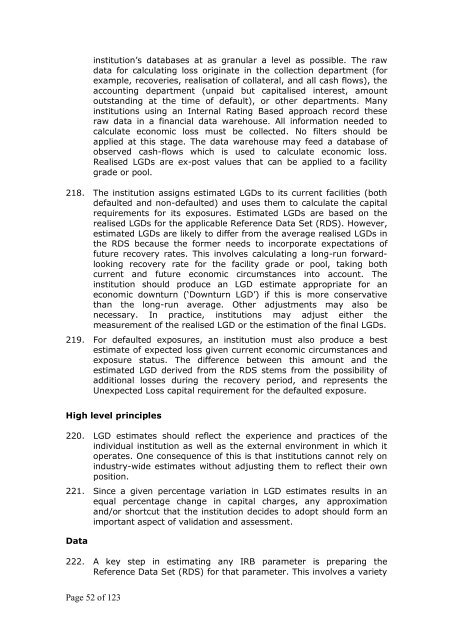CP10 (Full Document) - European Banking Authority
CP10 (Full Document) - European Banking Authority
CP10 (Full Document) - European Banking Authority
Create successful ePaper yourself
Turn your PDF publications into a flip-book with our unique Google optimized e-Paper software.
institution’s databases at as granular a level as possible. The raw<br />
data for calculating loss originate in the collection department (for<br />
example, recoveries, realisation of collateral, and all cash flows), the<br />
accounting department (unpaid but capitalised interest, amount<br />
outstanding at the time of default), or other departments. Many<br />
institutions using an Internal Rating Based approach record these<br />
raw data in a financial data warehouse. All information needed to<br />
calculate economic loss must be collected. No filters should be<br />
applied at this stage. The data warehouse may feed a database of<br />
observed cashflows which is used to calculate economic loss.<br />
Realised LGDs are expost values that can be applied to a facility<br />
grade or pool.<br />
218. The institution assigns estimated LGDs to its current facilities (both<br />
defaulted and nondefaulted) and uses them to calculate the capital<br />
requirements for its exposures. Estimated LGDs are based on the<br />
realised LGDs for the applicable Reference Data Set (RDS). However,<br />
estimated LGDs are likely to differ from the average realised LGDs in<br />
the RDS because the former needs to incorporate expectations of<br />
future recovery rates. This involves calculating a longrun forwardlooking<br />
recovery rate for the facility grade or pool, taking both<br />
current and future economic circumstances into account. The<br />
institution should produce an LGD estimate appropriate for an<br />
economic downturn (‘Downturn LGD’) if this is more conservative<br />
than the longrun average. Other adjustments may also be<br />
necessary. In practice, institutions may adjust either the<br />
measurement of the realised LGD or the estimation of the final LGDs.<br />
219. For defaulted exposures, an institution must also produce a best<br />
estimate of expected loss given current economic circumstances and<br />
exposure status. The difference between this amount and the<br />
estimated LGD derived from the RDS stems from the possibility of<br />
additional losses during the recovery period, and represents the<br />
Unexpected Loss capital requirement for the defaulted exposure.<br />
High level principles<br />
220. LGD estimates should reflect the experience and practices of the<br />
individual institution as well as the external environment in which it<br />
operates. One consequence of this is that institutions cannot rely on<br />
industrywide estimates without adjusting them to reflect their own<br />
position.<br />
221. Since a given percentage variation in LGD estimates results in an<br />
equal percentage change in capital charges, any approximation<br />
and/or shortcut that the institution decides to adopt should form an<br />
important aspect of validation and assessment.<br />
Data<br />
222. A key step in estimating any IRB parameter is preparing the<br />
Reference Data Set (RDS) for that parameter. This involves a variety<br />
Page 52 of 123

















